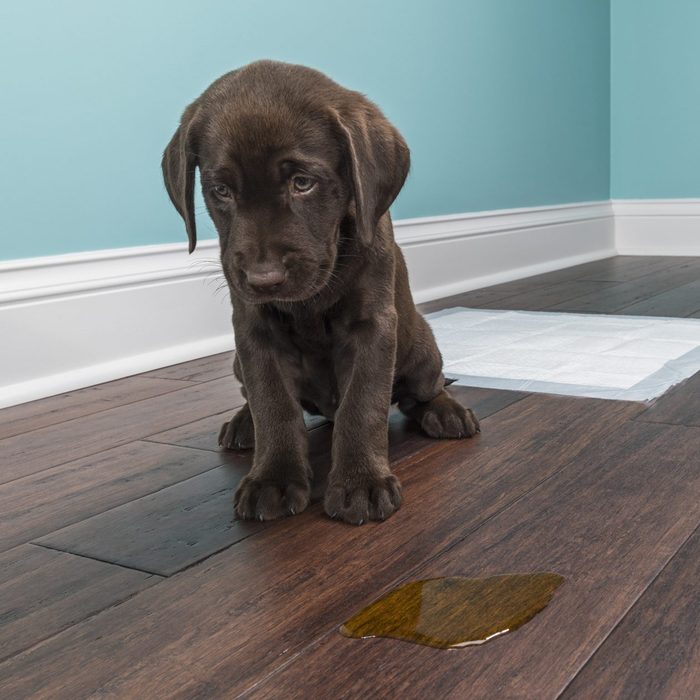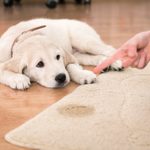8 Tips To Stop Your Dog From Peeing in the House

As a dog owner, you've likely dealt with accidents inside. These tips can teach you how to stop a dog from peeing in the house and keep your sanity.
Our editors and experts handpick every product we feature. We may earn a commission from your purchases.
If you own a dog, then you know the frustration of walking into a room and finding a puddle of urine or giant spot on the carpet. And while this is a natural and common occurrence with dogs, it’s still not pleasant to deal with.
Nicole Ellis, a certified professional dog trainer (CPDT-KA) and a pet lifestyle expert with Rover, offers the following tips on how to stop a dog from peeing in the house, so you can spend more time playing and less time cleaning.
On This Page
Start Tracking Your Dog’s Behavior
Take notes about your dog’s behavior and when they do certain things — eating, sleeping, drinking water and going potty. “This allows you to track how long they are holding it and help get you both on a routine to success,” Ellis says. Getting your dog to pee outside may be as simple as adjusting their potty schedule to fit their daily rhythm.
Use Positive Reinforcement
When your pup goes potty outside, be sure to praise them as soon as it occurs. Offer dog treats, give belly rubs or play. These dog training tools positively reinforce the idea of going outside and encourages them to continue.
Be sure to reward them as soon as it happens, so they understand it’s for peeing outside and not for coming through the door or some other behavior. As they learn, you can gradually wean off the treats. Until then, make it a big deal when they do go outside.
Keep Your Dog in the Room With You
Until your dog is fully potty-trained, keep them near you. This allows you to see the accident when it starts and quickly rush them outside to finish. Once they complete their business outside, you should immediately reward them so they associate going outside as a good thing.
Confine Your Dog When You’re Not Home
When dogs are left unsupervised, accidents are more likely. If you’re not at home, a dog crate, pen or small bedroom is helpful for controlling accidents. Dogs are less likely to pee where they sleep or play, so confining them to a small area can eliminate the temptation.
You can also try placing them in an area where they’re allowed to go, such as a dog run or a crate with a pee pad inside.
Treat a Puppy Differently Than a Senior Dog
Puppies and older dogs have more accidents, but likely for different reasons, according to Ellis. Puppies must be taught the difference between going potty inside versus outside. You will need to show the puppy where to go outside and offer frequent bathroom breaks.
Senior dogs may simply not be able to hold their bladder as long as they once could. In either case, you will need to continue using rewards. Adjusting the timing of when to take your dog outside is key.
Determine if Anxiety is the Real Issue
Some dogs pee in the house because they are nervous, anxious or overly excited. This occurs with puppies and older dogs. Your dog may react to loud voices and noises, strangers, sirens or other “scary” situations. If this occurs, identify the situation causing the fear or excitement.
You can help your dog by slowly introducing them to other people or situations where this may happen, or limiting these fearful interactions when possible. For some dogs, a thunder jacket helps ease anxiety.
Get Your Dog Spayed or Neutered
“Marking” an object in the home is common, especially with male dogs who haven’t been neutered. Though marking behavior can be triggered by various reasons — moving to a new home, the introduction of a new dog or even new furniture — it’s most often because a dog that hasn’t been spayed or neutered feels the effects of hormones and suffers from anxiety.
Spaying and neutering tends to lessen the urge for the dog to lift their leg and mark inside.
Rule Out a Medical Condition
Ellis says your veterinarian can determine if it’s an age issue, behavior problem or a medical condition like a urinary tract infection. Any sudden accidents out of character, more frequent urination and whimpering when urinating are all warning signs.
Never Do These Three Things When Your Dog Pees in the House
- Ignore the problem. Proper training or medical attention should help get to the bottom of the issue. Ellis says most dogs can master potty-training.
- Leave any pee behind. If you don’t use an effective enzyme cleaner each time your dog has an accident, they will continue to be attracted to that spot and will likely pee there again. Thoroughly clean the area to remove all traces of urine.
- Scold or yell at your dog. Don’t use fear as a motivator, because it can backfire in a big way. Instead of raising your voice, quickly rush your dog outside to finish their business.



